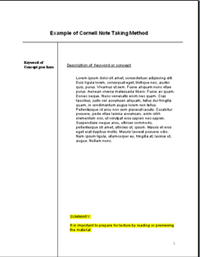Note-taking methods
There are a number of different ways to take notes, and it is best that you use the method you feel most at ease with. However, there are four general ideas that could help you to improve your note taking:
- Use white space to separate major ideas.
- Try to limit your notes to one concept or section per page.
- Use abbreviations and/or symbols where possible to avoid long sentences.
- Write down the information in your own words.
The Cornell Method
The Cornell Method is based on two columns: one containing the keyword or concept, and the other containing the description or notes associated with the keyword or concept. This method can be used while listening to the lecturer. In the right hand column, you can list the main ideas or write a paragraph and then on the left hand side note the keyword or concept that relates to your section of notes. At the bottom of the page you should write paragraphs summarising the information contained in the notes. Because this note-taking method identifies key concepts and also summarises main ideas, this can be a useful method for later revision.
The Outlining Method
This method involves writing a series of topics and sub-topics, and identifying them by indenting the text, numbering the lines, or using a dash or bullet point. This can be an effective note-taking method for visual learners, and is useful for organising your notes by topic, subtopics, and related concepts.
- Main Topic
- Sub-Topic
- Detailed points
- Detailed points
- Sub-Topic
- Second Main Topic
Mind mapping
A mind map is a diagram in which ideas, concepts and images are linked together around a central concept, keyword or idea. See the section on mind maps for more.
The Charting Method
Charting is effectively a table of rows and columns. The top row normally classifies the concept with descriptions or keywords listed in the row below.
| Theory | Who? | Proposed | Paper |
|---|---|---|---|
| Special theory of relativity | Albert Einstein | 1905 | 'On the electrodynamics of moving bodies' |
| Law of universal gravitation | Isaac Newton | 1687 | Philosophiae naturalis principia mathematica |
This method enables you to quickly identify facts and their relationships with other information, which can be useful when revising.
The Sentence Method
With this method you simply write every new concept or topic on a separate line. The idea is to identify the key concept and jot that down; do not try and write what the lecturer has said word for word. It is suggested that you leave lots of space between points to allow for additional notes later. You can also number the information if you wish. This method is useful when you have a lot of information to take notes about - it helps you focus on what is important. It is recommended that you use some form of visual aid (e.g., headings, arrows, coloured highlights or boxes) to group related points together.
Notetaking online tutorial
References and further reading
Buzan, T. (1995). The mind map book: Radiant thinking (Rev. ed.). BBC Books. [Massey Library link]
StudyUp Resources. (n.d.). Massey University. http://owll.massey.ac.nz/about-OWLL/studyup-resources.php
Todd-Williamson, C. (n.d.). Reading, note-taking, and how to use a literature matrix [online tutorial]. http://owll.massey.ac.nz/interactives/study-up-how-to-use-reading-techniques/content/index.html#/

